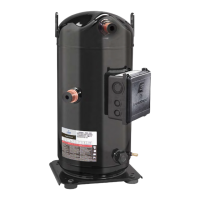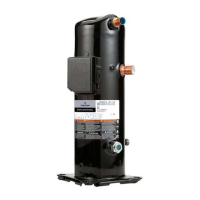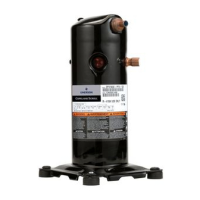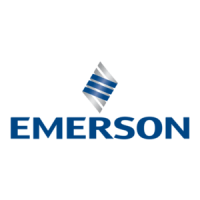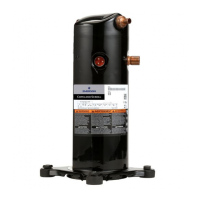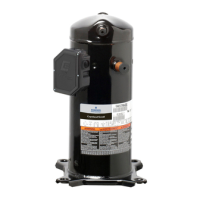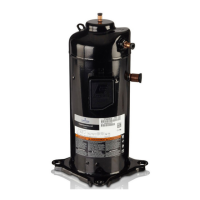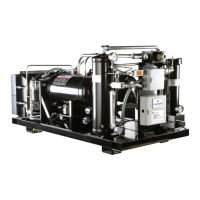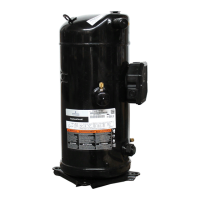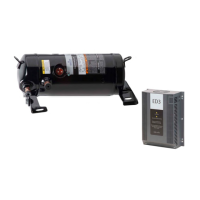AE4-1312 R2
© 2010 Emerson Climate Technologies
Printed in the U.S.A.
4
The reversing valve solenoid should be wired so that the
valve does not reverse when the system is shut off by
the operating thermostat in the heating or cooling mode.
If the valve is allowed to reverse at system shutoff,
suction and discharge pressures are reversed to the
compressor. This results in pressures equalizing through
the compressor which can cause the compressor to
slowly rotate until the pressures equalize. This condition
does not affect compressor durability but can cause
unexpected sound after the compressor is turned off.
Low Ambient Cut-Out
A low ambient cut-out is not required to limit air-to-air
heat pump operation. Air-to-water heat pumps must
be reviewed since this conguration could possibly run
outside of the approved operating envelope (Figure 5)
causing overheating or excessive wear.
Oil Type
Several types of compatible mineral oils are used in
the R-22 compressors. A standard 3GS oil may be
used if the addition of oil in the eld is required. See
the compressor nameplate for original oil charge. See
Application Engineering bulletin 17-1248 for more
information about oil types Emerson uses. A complete
recharge should be four uid ounces (118 ml) less than
the nameplate value. Some models have been released
for use with R407C or 134a and use polyol ester oil,
identied as POE, along with the charge quantity on
the nameplate. These models have an “E” in the 7th
place of the model number. An example would be the
ZR24K3E-PFJ compressor. Copeland
®
Ultra 22 CC
should be used if additional oil is needed in the eld.
Mobil Arctic EAL22CC or ICI Emkarate RL32CF oil may
be used to recharge these compressors if Ultra 22 is
not available. Compressors charged with POE may be
used with R-22 but compressors charged with mineral
oil may not be used with HFC refrigerants such as 407C
or 134a because they are not miscible.
Discharge Mufers
Flow through Copeland Scroll compressors is semi-
continuous with relatively low pulsation. External
mufers, where they are normally applied to piston
compressors today, may not be required for Copeland
Scroll. Because of variability between systems, however,
individual system tests should be performed to verify
acceptability of sound performance. When no testing is
performed, mufers are recommended in heat pumps.
A hollow shell mufer such as the Alco APD-1 or APD-
054 will work quite well. The mufer should be located
a minimum of six inches (15 cm) to a maximum of 18
inches (46 cm) from the compressor for most effective
operation. The further the mufer is placed from the
compressor within these ranges the more effective it
may be. If adequate attenuation is not achieved, use a
mufer with a larger cross-sectional area to inlet-area
ratio. The ratio should be a minimum of 20 to 1 with a
30 to 1 ratio recommended. The mufer should be from
four to six inches (10-15 cm) long.
Air Conditioning System Suction Line Noise and
Vibration
Copeland Scroll compressors inherently have low sound
and vibration characteristics. However, the sound and
vibration characteristics differ in some respects from
those of reciprocating compressors. In rare instances,
these could result in unexpected sound complaints.
One difference is that the vibration characteristic of
the scroll compressor, although low, includes two very
close frequencies, one of which is normally isolated
from the shell by the suspension of an internally
suspended compressor. These frequencies, which
are present in all compressors, may result in a low
level “beat” frequency that may be detected as noise
coming along the suction line into a house under some
conditions. Elimination of the “beat” can be achieved
by attenuating either of the contributing frequencies.
The most important frequencies to avoid are line and
twice-line frequencies for single-phase compressors
and line frequency for three phase compressors. This is
easily done by using one of the common combinations
of design congurations described in Table 3. The scroll
compressor makes both a rocking and torsional motion,
and enough exibility must be provided in the line to
prevent vibration transmission into any lines attached to
the unit. In a split system the most important goal is to
ensure minimal vibration in all directions at the service
valve to avoid transmitting vibrations to the structure to
which the lines are fastened.
A second difference of the Copeland Scroll is that
under some conditions the normal rotational starting
motion of the compressor can transmit an “impact”
noise along the suction line. This may be particularly
pronounced in three-phase models due to their
inherently higher starting torque. This phenomenon,
like the one described previously, also results from the
lack of internal suspension, and can be easily avoided
by using standard suction line isolation techniques as
described in Table 3.
The sound phenomena described above are not usually
associated with heat pump systems because of the
isolation and attenuation provided by the reversing valve
and tubing bends.
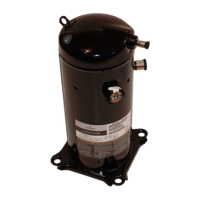
